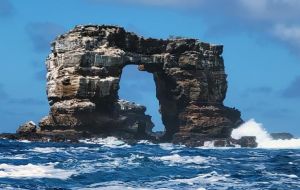MercoPress. South Atlantic News Agency
Ecuador: Darwin Arch off Galapagos falls down due to erosion
 The Arch used to look like this
The Arch used to look like this The Darwin Arch, a natural rock in the Ecuadorean Province of Galapagos, has collapsed due to “natural erosion,” the Ministry of the Environment and Water reported late on Monday.
“We inform that today, May 17, the collapse of the Darwin Arch was reported, the attractive natural bridge located less than a kilometer from the main island Darwin, the northernmost island of the # Galapagos archipelago. This event would be a consequence of natural erosion,” the Ministry posted on Twitter and showed a picture of how the structure looks now.
“Darwin's Arch is made of natural stone that at some point would have been part of Darwin Island, which is not open to visits by land. The site is considered one of the best places on the planet to dive, and observe schools of sharks and other species,” the official account read in a subsequent posting.
The rock structure — 43 meters (141 feet) high, 70 meters (230 feet) long and 23 meters (75feet) wide — is less than 1 kilometer (about half a mile) from Darwin Island and it’s a popular spot for scuba divers. It’s not accessible by land.
“Obviously all the people from the Galapagos felt nostalgic because it’s something we’re familiar with since childhood, and to know that it has changed was a bit of a shock,” said Washington Tapia, director of conservation at Galapagos Conservancy. “However, from a scientific point of view, it’s part of the natural process. The fall is surely due to exogenous processes such as weathering and erosion which are things that normally happen on our planet.”
The unique flora and fauna on remote islands, some 1,000 kilometers (600 miles) off the coast of mainland Ecuador are famed in part for inspiring British naturalist Charles Darwin (1809-1882), who used the Galapagos archipelago as a natural laboratory to develop his important and famous theory on the evolution of species.
This Natural Heritage of Humanity, in which some 30 thousand people live, is made up of 234 islands, islets and rocks. Only four islands in the archipelago are inhabited. The Government of Ecuador takes care of Galapagos as it is the scene of the Darwin Arch, and fundamental to world natural history.





Top Comments
Disclaimer & comment rulesCommenting for this story is now closed.
If you have a Facebook account, become a fan and comment on our Facebook Page!